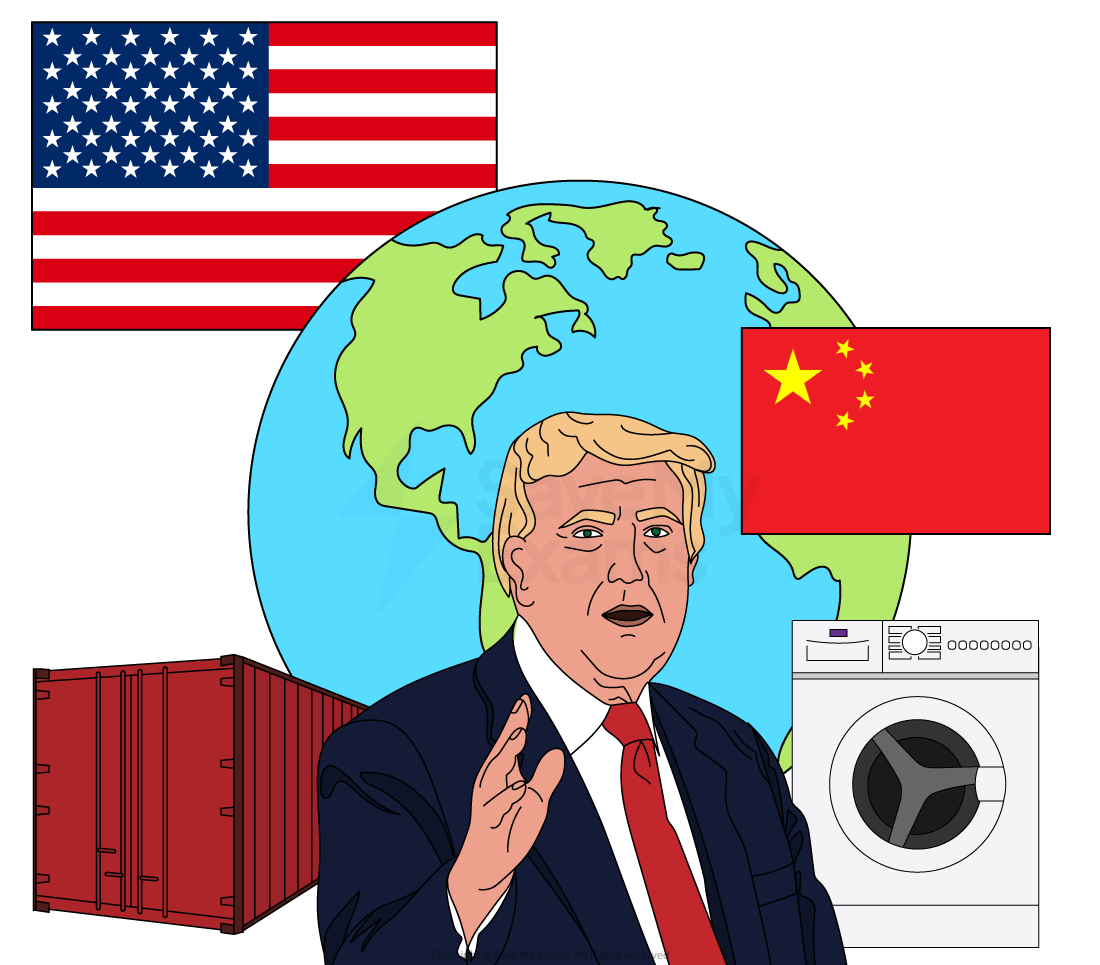Syllabus Edition
First teaching 2025
First exams 2027
Deficits & Surpluses (Cambridge (CIE) IGCSE Economics): Revision Note
Exam code: 0455 & 0987
Current account deficits and surpluses
A current account deficit occurs when the value of imports exceeds the value of exports
This means the country is spending more on foreign goods, services and income transfers than it is earning
Causes of current account deficits
1. Relatively low productivity
When a country’s firms are less efficient, their production costs are higher than firms in other countries
This makes exports more expensive and less competitive in global markets
For example, in the early 2010s, Greece struggled with low productivity, contributing to its large trade deficit and debt crisis
2. Relatively high exchange rate
A strong currency makes exports more expensive to foreign buyers and imports cheaper for domestic consumers
As a result, export sales fall and imports rise
3. Relatively high inflation
Higher domestic inflation increases the prices of goods and services to foreigners
Exported goods become more expensive than those from countries with lower inflation, causing demand to fall
At the same time, domestic consumers may switch to cheaper foreign goods, raising imports
For example, in the early 2000s, Zimbabwe experienced hyperinflation, destroying export competitiveness and leading to a reliance on imported essentials
4. Rapid economic growth
When household incomes rise quickly, people tend to buy more goods and services — including foreign products
This increase in import spending can worsen the current account balance.
For example, in India, periods of rapid growth have often been accompanied by widening trade deficits due to surging demand for imported oil, electronics and luxury goods
5. Non-price factors (e.g. poor quality or design)
Even if a product is affordable, poor quality or outdated design can lead to falling export sales
Domestic consumers may also prefer to buy higher-quality imports
For example, some developing economies struggle to increase exports due to inconsistent product quality while importing higher-quality goods from countries like Germany or Japan
Causes of current account surpluses
A current account surplus occurs when the value of exports exceeds the value of imports
This suggests the country is a net earner from trade and income flows
Relatively high productivity | Relatively low value of the country’s currency | Relatively low rate of inflation |
|---|---|---|
|
|
|
Consequences of deficits and surpluses
In the global economy, trade is a net-sum game
The total value of global exports equals the total value of global imports
This means that when one country runs a Current Account surplus, another must be running a Current Account deficit
Consequences of a Current Account deficit
1. Increasing unemployment
A fall in demand for domestically produced goods and services leads to lower output
As a result, fewer workers are needed, and unemployment rises
2. Slower economic growth or recession
Exports are a major component of real GDP
A sustained fall in exports can slow down economic growth or even push the economy into recession
3. Lower standards of living
With falling growth and rising unemployment, wages may fall and households will have less to spend
This leads to a decline in living standards
4. Increased borrowing
Persistent deficits, especially those caused by high import levels, may force a country to borrow more to fund its spending on foreign goods and services
5. Depreciating exchange rate
A weaker current account leads to depreciation of the national currency
While this can eventually boost exports, it also makes imports more expensive, raising the risk of cost-push inflation
Consequences of a Current Account surplus
Consequence | Explanation |
|---|---|
Rising employment |
|
Economic growth |
|
Higher living standards |
|
Demand-pull inflation |
|
Appreciating currency |
|
Cheaper imports |
|
Case Study
The United States Current Account Deficit and Policy Response under President Trump
The United States has run a current account deficit for decades, meaning it imports more goods, services, and income than it exports.
In 2023, the US current account deficit was over $900 billion, largely due to high imports of consumer goods, energy products, and capital equipment.
This deficit has been driven by:
Strong consumer demand for foreign goods
A strong dollar making imports cheaper and exports more expensive
Low national savings and high levels of government and consumer spending
Offshoring of US production to lower-cost economies, particularly China and Mexico
Trump's Actions
Under his first term as president (2017–2021), Donald Trump attempted to reduce the trade deficit using a mix of protectionist and nationalist economic policies under the banner of "America First"

These included:
Tariffs on Chinese imports
Introduced tariffs on steel, aluminium, and hundreds of billions of dollars’ worth of Chinese goods to protect domestic industries and reduce imports
Withdrawal from trade agreements
Pulled the US out of the Trans-Pacific Partnership (TPP) and renegotiated NAFTA into the USMCA to prioritise American jobs and manufacturing
Tax cuts and deregulation
Reduced corporation taxes to attract domestic investment and incentivise US-based businesses to boost production
Pressure on companies to reshore
Publicly criticised firms outsourcing jobs and encouraged manufacturing to return to US soil
Outcome
The trade deficit with China narrowed slightly in 2019, but the overall Current Account deficit remained large, due to strong consumer demand and higher imports from other countries like Vietnam and Mexico
Some US manufacturing sectors (e.g. steel) saw short-term boosts in production and employment
Tariffs led to higher prices for consumers and US firms relying on imported inputs, particularly in the automotive and technology industries
The US dollar remained strong, keeping imports attractive and limiting export competitiveness
There was limited long-term impact on reducing the deficit, as structural factors, such as the dollar’s global reserve status and low domestic saving, persisted

Unlock more, it's free!
Did this page help you?